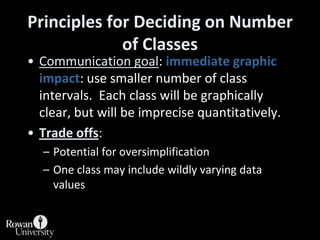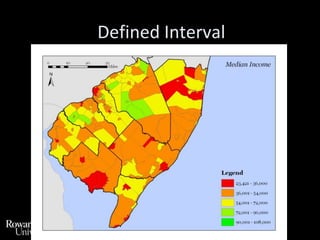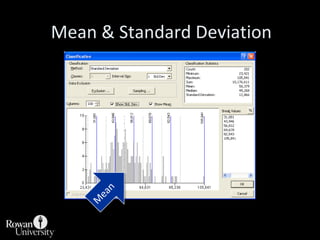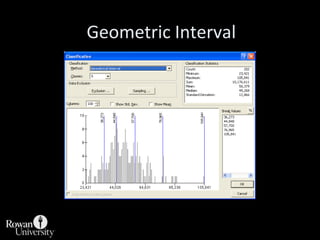Classification Systems
- 1. Classification SystemsIntro to Mapping & GIS
- 2. Levels of MeasurementNominal: “names” of items without intercorrelationOrdinal: implied order without inference to the spaces between valuesInterval: ranking considering values betweenRatio: meaningful base and ratios between values
- 3. Measurement ScalesNominal: Categorical measure [e.g., land use map]Lowest level [= only possible operation]Ordinal: Ranking MeasureLowest quantitative level [=, >, <]Strong ordinal: all objects placed in order, no ties.Weaker ordinal: all objects placed in order, but ties exist.Weakest ordinal: rating scales:Strongly agree, agree, disagree, strongly disagree.
- 4. Temperature Scale Conversion fromDegrees F to C Interval ScaleCan measure the size of a difference, but not how many times one observation is greater than another:Temperature: Consider ratio of 80°F and 40°F 80°F / 40°F = 2.00 26.6°C / 4.44°C = 5.99No true zero amount. At 0°F there is still some of the thing called temperature. But an interval of 20° is two times as large as the interval of 10°.Operations: [=, >, <, +, -]
- 5. Distance Scale Conversion fromMiles to Kilometers Ratio ScaleCan place numbers in ratio to each other:Edith makes three times as much money as Walter.Bill lives twice as far from here as Mary.20 miles / 10 miles = 2.032.3 km / 16.1 km = 2.0There is a true zero. You can have zero money. Ratio remains same through transformation of metric.Operations: [=, >, <, +, -, *, /, ^]
- 6. Overview of Map ClassingWhat is classing? Why do we class?Overriding principles.Principles for deciding:Number of classes.Method to use in classing.Methods of Classing:Natural BreaksEqual IntervalQuantileMean and Standard DeviationArithmetic ProgressionGeometric Progression
- 7. WhatIsClassing?Classification process to reduce a large number of individual quantitative values to:A smaller number of ordered categories, each of which encompasses a portion of the original data value range.Various methods divide the data value range in different ways.Varying the method can have a very large impact on the look of the map.
- 8. Fundamental PrinciplesEach of the original (unclassed) data values must fall into one of the classes. Each data value has a class home.None of the original data values falls into more than one class.These two rules are supreme: if any method results in classes that violate these rules, the resulting classes must be altered to conform to the two fundamental principles. Always.
- 9. Shorthand Way of Saying This Classes must be:Mutually exclusive &Exhaustive
- 10. Principles for Deciding on Number of ClassesRules of thumb:Monochrome color schemes: no more than 5 to 7 classes.Multi-hue map: no more than 9.it depends on other things such as ….
- 11. Communication goalWhat are you trying to prove or disprove with this map? Is it to communicate complex data or prove a simple point. Consider your audience.Complexity of Spatial PatternComplex data may require specific classification methods.Available Symbol TypesPrinciples for Deciding on Number of Classes
- 12. Principles for Deciding on Number of ClassesCommunication goal: quantitative precision: use larger number of class intervals. Each class will encompass a relatively small range of the original data values and will therefore represent those values more precisely.Trade offs:Too much data to enable the information to show through.Indistinct symbols.
- 14. Principles for Deciding on Number of ClassesCommunication goal: immediate graphic impact: use smaller number of class intervals. Each class will be graphically clear, but will be imprecise quantitatively. Trade offs:Potential for oversimplificationOne class may include wildly varying data values
- 16. Principles for Deciding on Number of ClassesComplexity of Spatial PatternHighly ordered spatial distribution can have more classes. Complex pattern of highly interspersed data values requires fewer classes.
- 19. Classing Methods
- 20. Natural BreaksAttempts to create class breaks such that there is minimum variation in value within classes and maximum variation in value between classes.
- 21. Default classification method in ArcMap.Natural Breaks
- 22. Natural Breaks
- 23. AdvantagesMaximizes the similarity of values within each class.Increases the precision of the map given the number of classes.DisadvantagesClass breaks often look arbitrary.Need to explain the method.Method will be difficult to grasp for those lacking a background in statistical methods. Natural Breaks
- 24. Equal IntervalEach class encompasses an equal portion of the original data range. Also called equal size or equal width.Calculation:Determine rangeof original data values:Range = Maximum - MinimumDecide on number of classes, N.Calculateclass width:CW = Range / N
- 25. Class Lower Limit Upper Limit 1 Min Min + CW 2 Min + CW Min + 2CW 3 Min + 2CW Min + 3CW . . . . . .N Min + (N-1) CW Max Equal Interval
- 26. Example: Min = 0; Max = 100; N = 5Range = 100 - 0 or 100Class Width = 100 / 5 or 20Class Lower Limit Upper Limit 1 0 to 20 2 20 to 40 3 40 to 60 4 60 to 80 5 80 to 100Equal Interval
- 27. Example: Min = 0; Max = 100; N = 5Range = 100 - 0 or 100Class Width = 100 / 5 or 20Class Lower Limit Upper Limit 1 0 to 20 2 21 to 40 3 41 to 60 4 61 to 80 5 81 to 100Accepted Equal IntervalMust beMutually Exclusive
- 28. Equal Interval
- 29. Equal Interval
- 30. Advantages:Easy to understand, intuitive appealEach class represents an equal range or amount of the original data range.Good for rectangular data distributionsDisadvantages:Not good for skewed data distributions—nearly all values appear in one class.Equal Interval
- 31. Five Classes Equal Interval
- 33. Defined IntervalEach class is of a size defined by the map author.Intervals may need to be altered to fit the range of the data.Calculation:Set interval size.Determine rangeof original data values:Range = Maximum – MinimumCalculatenumber of classes:N = Range / CW
- 34. Example: Min = 40; Max = 165; CW = 25Range = 165 - 40 = 125N = 125 / 25 = 5 classes Class Lower Limit Upper Limit 1 40 to 65 2 66 to 90 3 91 to 115 4 116 to 140 5 141 to 165Defined IntervalMust beMutually Exclusive
- 35. Defined Interval
- 36. Defined Interval
- 37. Advantages:Easy to understand, intuitive appealEach class represents an specified amountGood for rectangular data distributionsGood for data with “assumed” breaksDecades for years, 1,000s for money, etc.Disadvantages:Not good for skewed data distributions—many classes will be empty and not mapped.Defined Interval
- 38. Quantile ClassesPlaces an equal number of cases in each class.Sets class break points wherever they need to be in order to accomplish this.May not always be possible to get exact quantiles:Number of geounits may not be equally divisible by number of classes. [21 / 5].Putting same number of cases in each class might violate mutually exclusive classes rule.12 values in 4 classes: 0 0 0 |0 0 3| 4 4 5| 6 7 7 NO0 0 0 0 0 |3| 4 4 5| 6 7 7 YES
- 39. Quantile
- 40. Quantile
- 41. Quantile ClassesAdvantages:Each class has equal representation on the map.Intuitive appeal: map readers like to be able to identify the “top 20%” or the “bottom 20%”Disadvantages:Very irregular break points unless data have rectangular distribution.Break points often seem arbitrary. Remedy this with approximate quantiles.
- 42. Mean & Standard DeviationPlaces break points at the Mean and at various Standard Deviation intervals above and below the mean.Mean: measure of central tendency.Standard Deviation: measure of variability.
- 43. Mean & Standard DeviationClass Lower Limit Upper Limit 1 Min Mean – 1.5*SD 2 Mean – 1.5*SD Mean – 0.5*SD 3 Mean – 0.5*SD Mean + 0.5*SD 4 Mean + 0.5*SD Mean + 1.5*SD 5 Mean + 1.5*SD Mean + 2.5*SD 6 Mean + 2.5*SD Max
- 44. Mean & Standard DeviationMean
- 45. Mean & Standard DeviationClearly showswhat’s “average”.
- 46. Mean & Standard DeviationAdvantages:Statistically oriented people like it.Allows easier comparison of maps of variables measured in different metrics. Income and education levels.Disadvantages:Many map readers are not familiar with the concept of the standard deviation.Not good for skewed data.
- 47. Geometric IntervalThe width of each succeeding class interval is larger than the previous interval by a constant amount. Calculating the constant amount, CW:Decide on number of classes, N.Calculate the range: R = Max - MinSolve: R = CW + 2CW + . . . + NCWfor CW
- 48. Geometric: Class Widths Class Width1 CW 2 2CW 3 3CW 4 4CW 5 5CW
- 49. Geometric Progression ClassesThe width of each succeeding class interval is larger than the previous interval by a exponentially varying amount. Calculating the BASE amount, CW:Decide on number of classes, N.Calculate the range: R = Max - MinSolve:
- 50. Geometric: Class ExampleMax = 160; Min = 10; R = 150; CW = 10Class Lower Limit + CLASS* CW = Upper Limit 1 10 + 10 = 20 2 20 + 20 = 40 3 40 + 30 = 70 4 70 + 40 = 110 5 110 + 50 = 160
- 53. Geometric IntervalAdvantages:Uneven, but regular class breaks.Tends to even out class frequencies for skewed distributions while making class widths relatively small in areas where there is high frequency.Disadvantages:Uncommon.Unequal width classes.
- 54. Making a sensible mapRemember, class breaks should make sense to both you and the audience.Most of the time, you should change what ArcMap produces by default.Median Year Built
- 55. Years shouldn’t be demical!
- 56. Number formattingArcGIS assumes by default that numbers not explicitly set as integers are floating point (decimal) numbers.ArcGIS also assumes all floating point numbers should show 6 places after the decimal point.
- 57. Layer PropertiesUnder the Fields tab in the Layer Properties, you can set aliases for the field names, as well as define the format of the field.Set numbers to have no zeroes after the decimal point.
Editor's Notes
- #2: This week, we will be discussing classification systems. Classification systems are the methods employed by GIS software to categorize large quantities of data into more manageable groups that can then be mapped. Before we can jump into classification itself, let’s consider the different levels of measurement employed when analyzing data.



![Measurement ScalesNominal: Categorical measure [e.g., land use map]Lowest level [= only possible operation]Ordinal: Ranking MeasureLowest quantitative level [=, >, <]Strong ordinal: all objects placed in order, no ties.Weaker ordinal: all objects placed in order, but ties exist.Weakest ordinal: rating scales:Strongly agree, agree, disagree, strongly disagree.](https://image.slidesharecdn.com/lecture08classification-110305185328-phpapp01/85/Classification-Systems-3-320.jpg)
![Temperature Scale Conversion fromDegrees F to C Interval ScaleCan measure the size of a difference, but not how many times one observation is greater than another:Temperature: Consider ratio of 80°F and 40°F 80°F / 40°F = 2.00 26.6°C / 4.44°C = 5.99No true zero amount. At 0°F there is still some of the thing called temperature. But an interval of 20° is two times as large as the interval of 10°.Operations: [=, >, <, +, -]](https://image.slidesharecdn.com/lecture08classification-110305185328-phpapp01/85/Classification-Systems-4-320.jpg)
![Distance Scale Conversion fromMiles to Kilometers Ratio ScaleCan place numbers in ratio to each other:Edith makes three times as much money as Walter.Bill lives twice as far from here as Mary.20 miles / 10 miles = 2.032.3 km / 16.1 km = 2.0There is a true zero. You can have zero money. Ratio remains same through transformation of metric.Operations: [=, >, <, +, -, *, /, ^]](https://image.slidesharecdn.com/lecture08classification-110305185328-phpapp01/85/Classification-Systems-5-320.jpg)
































![Quantile ClassesPlaces an equal number of cases in each class.Sets class break points wherever they need to be in order to accomplish this.May not always be possible to get exact quantiles:Number of geounits may not be equally divisible by number of classes. [21 / 5].Putting same number of cases in each class might violate mutually exclusive classes rule.12 values in 4 classes: 0 0 0 |0 0 3| 4 4 5| 6 7 7 NO0 0 0 0 0 |3| 4 4 5| 6 7 7 YES](https://image.slidesharecdn.com/lecture08classification-110305185328-phpapp01/85/Classification-Systems-38-320.jpg)



















